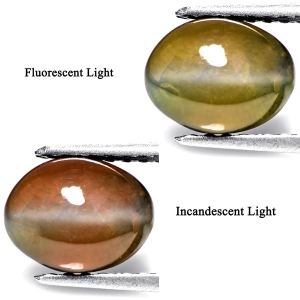Alexandrite: The Magical Gemstone
Alexandrite is a variety of Chrysoberyl which displays a color change (alexandrite effect) dependent upon light, along with strong pleochroism. This extremely rare gemstone of fairly recent history owes its name to the fact that it was first discovered in the Urals in 1830, on the day of Prince Alexander of Russia’s coming of age.
Appearance
 Green: It can be almost emerald-colored, but is more often yellowish or brownish green. Its main characteristic is the ability to change color if exposed to a light source rich in red rays; by candlelight or tungsten light, it turns red or reddish. This unusual phenomenon is what distinguishes it from other green Chrysoberyl. This pronounced color change from green to red is highly prized and, as always, the exact tone of the color, or colors, is important, the ideal being brilliant green turning to fiery red although dull green turning reddish or slightly turbid blood red is more common. Given alexandrite’s extreme rarity, even stones with the number of inclusions are cut. It is given an oval or round, mixed cut, or a rectangular, step cut. Alexandrite is so rare that few people have ever seen one; and for perhaps this reason, the name is applied to other, mainly synthetic stones, not remotely like it (Usually violet-colored synthetic corundums).
Green: It can be almost emerald-colored, but is more often yellowish or brownish green. Its main characteristic is the ability to change color if exposed to a light source rich in red rays; by candlelight or tungsten light, it turns red or reddish. This unusual phenomenon is what distinguishes it from other green Chrysoberyl. This pronounced color change from green to red is highly prized and, as always, the exact tone of the color, or colors, is important, the ideal being brilliant green turning to fiery red although dull green turning reddish or slightly turbid blood red is more common. Given alexandrite’s extreme rarity, even stones with the number of inclusions are cut. It is given an oval or round, mixed cut, or a rectangular, step cut. Alexandrite is so rare that few people have ever seen one; and for perhaps this reason, the name is applied to other, mainly synthetic stones, not remotely like it (Usually violet-colored synthetic corundums).
Distinctive features
The changing-color is an unmistakable characteristic. However, in the last few years, small quantity of green or bluish-colored grossular garnet that turn red like alexandrite have been found in East Africa. To distinguish between the two, it is useful to look for signs of birefringence, as garnet, unlike alexandrite, is singly refractive. The refractive indices of the two stones, on the other hand are very similar as are their densities.
Alexandrite Cat's Eye
An alexandrite cat's eye is a chrysoberyl cat's eye that changes color. The rutile inclusions oriented in one direction in an Alexandrite cause the Cat's Eye to form when cut as a cabochon. Alexandrite Cat's Eye happens to be among the rarest and the most expensive gemstones.
Occurrence
Found in limited quantities in Russia, Brazil, India, Sri Lanka (Ceylon), and some East African countries (Zimbabwe and Tanzania)

Value
Fine stones are extremely valuable and sometimes even more expensive than emeralds, rubies, and sapphires. When the colors are dull the value falls appreciably, but because of its rarity all alexandrite is expensive and is a collector’s item.
Simulants and Synthetics
Attempts have been made in the past to imitate Alexandrite’s change in color using synthetic spinel and corundum, but the results have been modest. More recently a violet-colored synthetic corundum has been widely marketed under the name of alexandrite, despite its lack of any real similarity to the natural stone. However, many who have never seen true alexandrite apply the name to this synthetic corundum and possibly for this reason, some manufacturers of synthetic corundum call their violet stones “alexandrite type”. Synthetic alexandrite has also recently been produced, but mainly for industrial purposes. For the time being, therefore, synthetic alexandrite is even rarer than the natural variety.
A Rare Alexandrite Cat's Eye from our stock:











